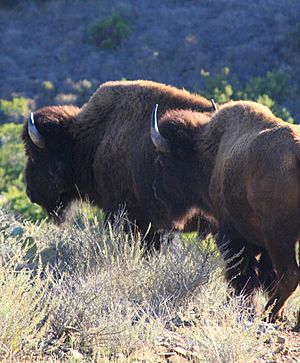Catalina Island bison herd facts for kids
The Catalina Island bison herd is a special group of American bison living on Catalina Island. This island is off the coast of Southern California. These bison were brought to the island in 1924 and 1925. Today, they are very popular with visitors. You can even see bison images painted on buildings and used as weather vanes. Over the years, the herd grew to as many as 600 bison. Now, there are about 100 bison on the island.
How the Bison Arrived
Many people believe the bison came to Catalina Island for a silent film called The Vanishing American in 1924. However, that movie does not show any bison or look like Catalina Island. Instead, it is now thought that the bison were brought for another silent film, The Thundering Herd, which was released in 1925.
A film company called Lasky filmed on the island in 1925. They left about 30 bison behind with permission from the island's owner, William Wrigley Jr. Other reports say that 16 bison came from a larger group of 86 bison. These bison were extra animals from Yellowstone National Park. They were sent to California in December 1924.
The group now going to Hollywood will help finish this movie. After the movie is done, they will be set free on Catalina Island.
Other bison from Yellowstone were sent to cities, parks, and private places. The bison were free to take, but you had to pay for shipping. In 1949, a report said that 13 male bison were left in Skull Canyon. Later, in 1934, Wrigley bought 17 more bison, mostly females, from Colorado. Some were sold, and 12 were shipped to the island. A 1961 report said there were two herds that did not mix.
Taking Care of the Bison
The Catalina Island Conservancy looks after the bison herd. It is very important to control the number of bison. This helps keep the island's environment healthy. Bison are not originally from Catalina Island. The Conservancy makes sure there are not too many bison. This prevents them from harming native plants and animals.
In 2003, a study looked at how many bison the island could support. It found that a herd of 150 to 200 bison would be good for the bison and better for the island's nature. In the past, some bison were moved to the mainland and sold.
In 2004, the Conservancy worked with Native American tribes. These included the Morongo Band of Mission Indians, the Tongva (who lived on Catalina long ago), and the Lakota tribe. One hundred bison were moved to the Great Plains in South Dakota. This helped the bison and the island.
Scientists found that the Catalina bison have some genes from cattle. This means they are not pure bison. They also noticed that these bison are a bit smaller. They have different leg lengths and jaw shapes. Sometimes, they have lower fertility.
Bison and People
Bison are wild animals, and it is important to be careful around them. Sometimes, people can get hurt. On August 26, 2015, a worker was injured by a bison near Tower Peak. On February 17, 2018, a man camping was also hurt by a bison. Always keep a safe distance from these animals.
See also
- Conservation of American bison
- Catalina Bird Park
- Camp Pendleton bison herd


